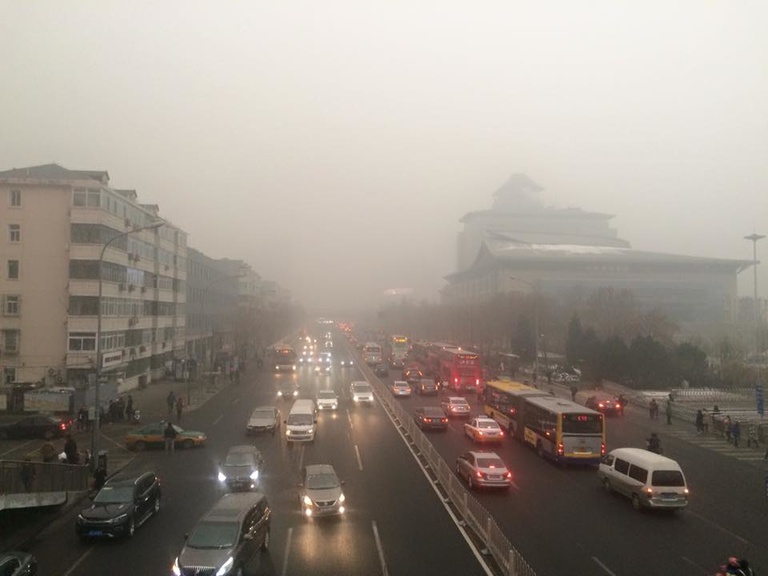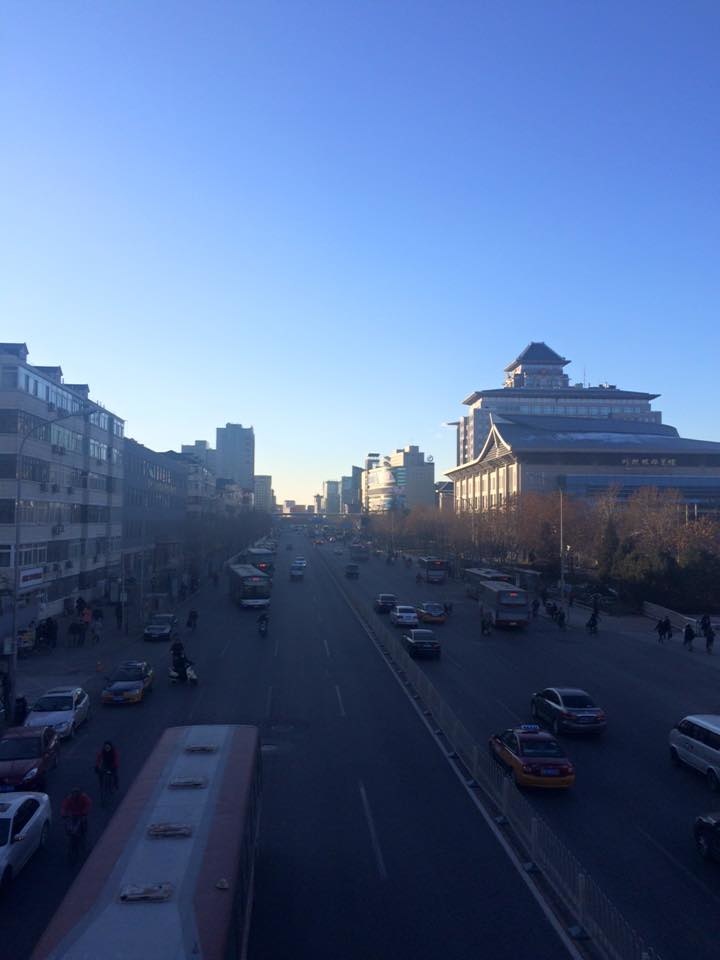By Jeffrey Ding*

Airpocalypse Beijing (12/1), overlooking Peking University. Picture by: Nick Szappanos.
Part I. Tell Me How I’m Supposed to Breathe in This Air
The first thing I check every morning is the U.S. Embassy’s AQI (Air Quality Index). This Tuesday, the AQI reads “beyond index” (>500 AQI), which is a diplomatic way of saying “deathly.” The annoying lump in my throat and its companion “Beijing cough” reappears. When I look outside, I wonder if I have been transported back to the 1950s to London’s Smog Menace when couples kissed with their masks on and people relied on the blind to lead them home.
I can’t help but question why I chose to study here, a decision that will probably cost me in life expectancy.
Part II. The Invisible Visibility of Smog
In some ways, air pollution is an invisible scourge. PM2.5, which refers to airborne particles smaller than 2.5 microns in diameter, cannot be seen by the naked eye. For instance, you can’t see Benzopyrene, one of fifteen types of carcinogens found in China’s PM2.5 mix. Air pollution is often an underrated menace. Polar bears stranded on shrinking ice caps, islands consumed by rising sea levels, and rampant desertification are all easily pictured. Meanwhile, outdoor air pollution quietly causes between 350,000 and 1.2 million premature deaths in China, depending on the study.i
In other ways, the effect of smog on visibility makes air pollution an undeniable problem. Everyone on campus talks about it; everyone on the web complains about it. Earlier this year, investigative journalist Chai Jing released a documentary, titled “Under the Dome”, which rode the this wave of popular consciousness to over 200 million views before the censors took it offline.ii When I watched it for the first time, I could understand why the video went viral. In one scene, Chai Jing asks a six-year old child from Shanxi whether she has ever seen white clouds. Her answer breaks your heart. This is the good of concentrated visibility: it can mobilize the public, inspire individual change, lead to better enforcement of environmental laws, and motivate government policy.
Part III. Chasing Murky Views
That Friday, I had dinner with University of Iowa graduates who work as reporters in Beijing. They were both exhausted from working insane hours to output article after article on the smog. I think they were also exhausted from the singular focus on smog. It’s understandable in a view-driven age. This week, the trending topics on all the major social media platforms were Beijing’s “airpocalypse”. What’s funny (and a little scary) is if you search “Beijing” and “airpocalypse”, you will find articles with similar headlines and introductions but written for different dates. If Beijing has survived multiple “airpocalypses”, does that make this city heaven-on-earth?
This is the bad of air pollution’s hypervisibility: we only view the smog, but we don’t investigate what the smog reveals about the Chinese government’s ability to follow through on pollution targets; we may blithely reference some vague irony in the juxtaposition of Beijing’s smog and China’s prominent role in the Paris climate talks, but we don’t read the articles with reference sections that analyze China’s significant climate pledges and investments in clean energy. Because it is easier to connect smog to stereotypes about China, and to some extent Chinese people – dirtiness, low quality goods, backwards. And it is much harder to read reports from Pew Clean Energy Initiative on how China holds a wide lead in the clean energy race,iii because then we would have to consider whether there are elements of China’s governance structure from which the United States could learn. It is especially difficult to dig past the end-of-pipe pollution to its root causes, because then we would realize that much of China’s pollution is emitted in the creation of infrastructure and goods that meet the needs of Western consumers.

Paradise Beijing (12/2), overlooking Peking University. Picture by: Nick Szappanos.
Part IV. All the Smog We Cannot See
The smog-based myopia extends further. A couple of days after the “beyond index” smog cleared, I attended a tour of Beijing’s nearby waterways. After befriending the tour guide, I learned he is a freelance blogger who promotes travel destinations but his passion lies in environmental protection. Unfortunately, he limits his posts on water pollution because the government might “take him out to tea”, which is euphemism for an intimidating meeting with the public security bureau. Chai Jing’s “Under the Dome” on air pollution was only censored because it went crazy viral, but usually people can post freely on air pollution because it is undeniably visible. The guide told me, “When people talk about China’s environmental problem, they think of air pollution, but water pollution and scarcity is the more critical issue.” Nearly 60 percent of China’s groundwater is polluted, and China is one of the world’s most water-stressed countries.iv
Even within the less noticeable water issues, there are aesthetic divisions. As we walk alongside the Qinghe River, the guide tells us the northern parts of Beijing’s waterways have relatively good quality water, but the southern parts suffer at their expense. Even water that is not used for drinking – such as the part of the Qinghe we walked – is cleaned in treatment facilities to better the aesthetic of Beijing as a cleanly modern city, but the remaining polluted water is passed along downstream. The parallel to the global north-south disparity – a result of the growth of developed countries through exporting production and pollution to developing countries - is almost too obvious.
I often fall prey to “out of sight, out of mind”. Even with air pollution, the hyper-visibility comes in cycles. After the wind blew away the smog, I played soccer for three hours, forgetting about where the smog ends up. In fact, China’s air pollution traverses the country, and even lands in places as far away as Los Angeles. I encounter water issues even less because I mostly drink bottled water in Beijing. When I asked the water tour guide about the sources of bottled water, he mentioned that some companies source their bottled water from Tibetan rivers, which originate in mountain ranges. Sadly, climate change could cause mountain glaciers to melt too rapidly, destroying a sustainable source of clean water.
In one episode of Sinica, my favorite podcast on China, the hosts discuss why more foreigners are staying longer in China, despite the air. They say something that stuns me with its simple clarity – an answer to the “Why am I sacrificing life expectancy units here?” question. The future of the world is being made here. China’s path – as it combats air pollution, water scarcity, and climate change – will either be the new model or historical warning for 21st century sustainable development. I am so excited to be here to see it.
Just don’t miss the forest surrounding the smoggy trees.
i Studies by the World Bank, World Health Organization, and the Chinese Academy for Environmental Planning concluded between 350,000 and 500,000 premature deaths. A 2010 Global Burden of Disease Study states 1.2 million premature deaths.
ii The documentary can still be viewed here, with crowdsourced English subtitles: https://www.youtube.com/watch?v=MhIZ50HKIp0
iii http://www.pewtrusts.org/en/research-and-analysis/reports/2014/04/03/whos-winning-the-clean-energy-race-2013
iv Report released by Chinese central government
*Jeffrey Ding is a senior from Iowa City, IA studying political science, economics and Chinese at the University of Iowa. He will be spending this fall in Beijing, China on the CIEE Advanced Chinese Studies program and will continue living there next semester as he pursues an internship funded by a Boren Scholarship.